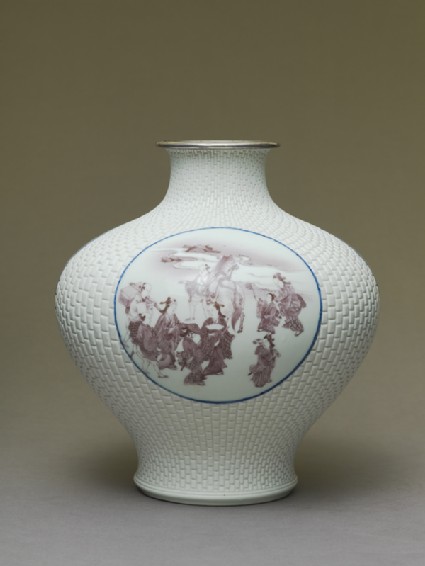Browse: 2213 objects
- Reference URL
Actions
Baluster vase with cartouches depicting Mount Fuji, samurai, and chickens
-
Details
- Associated place
-
Asia › Japan › Honshū › Kantō › Kanagawa prefecture › Yokohama › Ota › Makuzu kiln-site (place of creation)Asia › Japan › Honshū › Mount Fuji (subject)
- Date
- 1890s
- Artist/maker
-
Miyagawa Kōzan (1842 - 1916) (potter)Makuzu kiln (1871 - 1959) (potter)
- Material and technique
- porcelain, thrown, with moulded decoration, and underglaze painting in copper-red; silver mounts
- Dimensions
-
23.5 cm (height)
22 cm (diameter)
- Material index
- Technique index
- Object type index
-
container › vessel › vase › baluster vase
- No. of items
- 1
- Credit line
- Purchased with the assistance of the Story Fund, 1996.
- Accession no.
- EA1996.132
-
Further reading
Impey, Oliver, and Joyce Seaman, Japanese Decorative Arts of the Meiji Period 1868-1912, Ashmolean Handbooks (Oxford: Ashmolean Museum, 2005), no. 4 on p. 16, p. 8, illus. pp. 16-17
Glossary (2)
porcelain, underglaze painting
-
porcelain
Ceramic material composed of kaolin, quartz, and feldspar which is fired to a temperature of c.1350-1400⁰c. The resulting ceramic is vitreous, translucent, and white in colour.
-
underglaze painting
Painting applied to ceramic material before a transparent, or monochrome or coloured glaze for Islamic objects, is applied. The technique was initially developed in China.
Location
Objects are sometimes moved to a different location. Our object location data is usually updated on a monthly basis. Contact the Jameel Study Centre if you are planning to visit the museum to see a particular object on display, or would like to arrange an appointment to see an object in our reserve collections.
Collection trails
Galleries
Publications online
-

Japanese Decorative Arts of the Meiji Period
Squat baluster porcelain vase with moulded white body and three panels painted in underglaze copper red with chickens, temple buildings in a landscape with Mount Fuji and samurai with attendants beside a stream. Silver mounted rim. Signed with underglaze blue seal-mark on the base; Makusu gama Kōzan sei (made at the Makusu Kōzan kiln).
The deeply moulded pattern resembles that on a vase, now in the Khalili Collection, that Miyagawa (Makuzu) Kōzan (1842-1916) exhibited at the World's Columbian Exposition in Chicago in 1893. His family name was Miyagawa, but he is usually referred to by his art name, Makuzu. His kiln was at Ōta, in Yokohama, and such was his versatility that he was sometimes, in his lifetime, called 'The wizard of Ōta'. Kōzan was so eclectic in his choice of styles that it is difficult to date his work; the most successful dating system is based upon the shape and style of signature, for he seems to have changed the signature several times. The blue and white seal-style signatures are actually written, not stamped.
© 2013 University of Oxford - Ashmolean Museum













